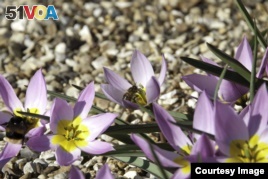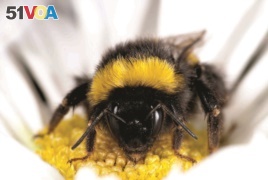February 19,2014
A new study finds that honeybees managed by beekeepers could be infecting their wild bumblebee cousins with disease.
While honeybees and bumblebees come from the same bee family, the smaller honeybees live in managed hives, which beekeepers move from farm to farm to pollinate crops and produce honey. Bumblebees live in much smaller colonies in the wild. Both get pollen from the same flowers and crops, which is how they come into contact.

A bumblebee and honeybee foraging on the same flower species. Data from the laboratory as well as from the field show that infectious agents, so far thought species specific, are widespread in the pollinator assemblage. (Credit: Matthias A. Furst)
Study co-author Matthias Furst of Royal Holloway University of London says lab experiments show that bumblebees suffer from the same parasites, pathogens and disease as honeybees.
“We infected bees and checked their infection status and their longevity, and we found a significant reduction in their longevity, so these pathogens are really infective and really impact our bee population.”
Bumblebees' lifespans were shortened by one-quarter to one-third, reducing the amount of food they could provide to their colonies. Co-author Mark Brown, also with Royal Holloway University, says that loss is greater for bumblebees because their colonies, or family groups, are much smaller than honeybees' hives.
“While honeybees may have anywhere up to 50,000 workers in a hive, losing one worker is not a big problem," Brown said. "Bumblebees, depending upon the species, live in groups of anywhere between a few tens to a few hundreds of workers. And so every worker you lose, or whose life is shortened, is going to have a much larger impact on the colony, its survival and its reproduction.”
Furst says his team then checked infections in both managed and wild bee populations across England.

Bumblebee forages on a flower, which is frequently visited by a multitude of insects and therefore constitutes a hotspot for disease transmission. (Credit: Matthias A. Furst)
Viral infection is triggered by a common parasite, the Varroa mite, that spreads rapidly in beehives. Brown says methods exist to control the mites to some extent, but they remain a tricky problem.
“Because most of our controls are based on chemicals, and the mites can evolve resistance to those chemicals," he said. "And so we need coordinated control strategies, but also the development of new control strategies that are going to be effective in the long term.”
Brown hopes their study, published in Nature, focuses greater attention not only on managed pollinators, but also on the services provided by their wild counterparts.
"We need to think about how we manage managed honeybees - not just from perspective of looking after them, but potentially from the perspective of looking after our wild bees, too,” he said.
Brown adds that the sample infection numbers are conservative, so overall infection rates are most likely higher, underscoring the critical need for more work to protect the bees, which pollinate three-quarters of the world’s food crops, contributing some $200 billion to the global economy.